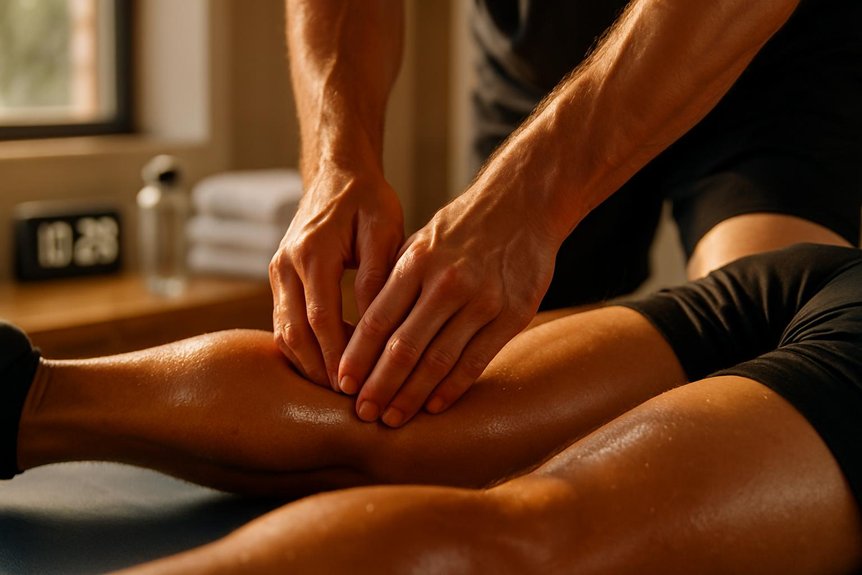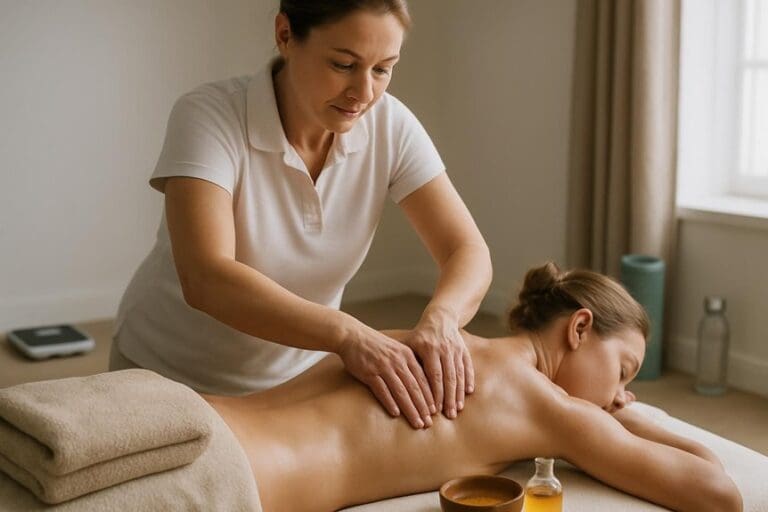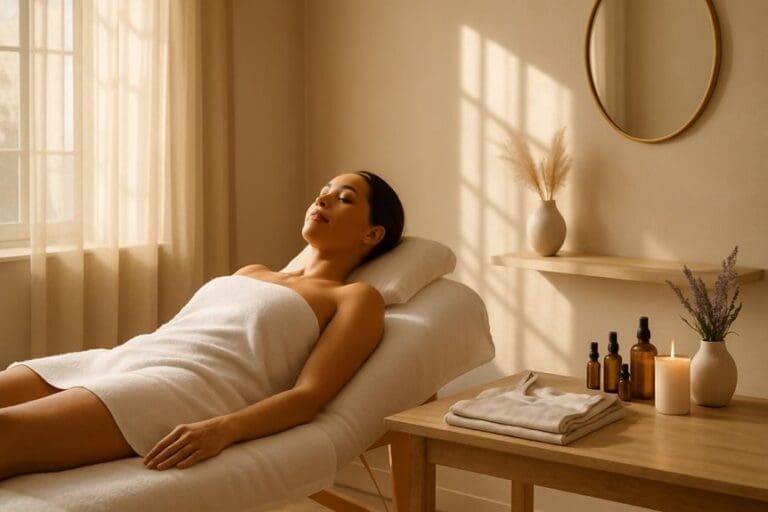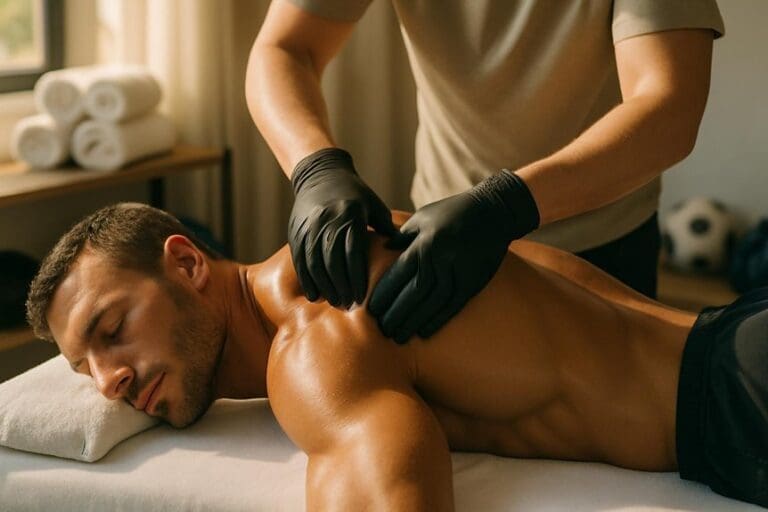An athletic massage typically lasts 30–90 minutes, with 60 minutes most common. Duration depends on training load, event timing, injury status, and regions involved. Shorter sessions (30–45 min) target acute pain or a single area. Longer sessions (60–90 min) address kinetic chains like calf–hamstring–glute and thoracolumbar fascia, using graded pressure, friction, and joint mobilisations. Pre-event work is brief and light (15–30 min). Post-event recovery spans 15–60 min with lymphatic focus. The ideal length shifts with goals and phase—more details follow.
Typical Sports Massage Durations Explained
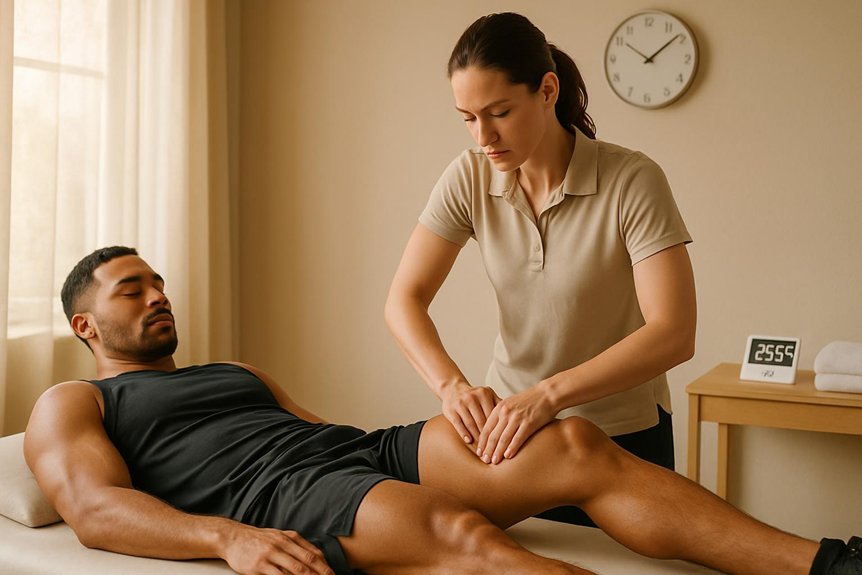
Most athletic massage appointments fall into three practical lengths: 30, 60, and 90 minutes. Each duration supports targeted clinical aims while honoring the nervous system’s need for safety and calm.
In Spa & Massage clinics across London, therapists structure time around tissue priorities and recovery goals.
A 30-minute session focuses on one region—such as the calves and Achilles complex, rotator cuff and scapulothoracic tissues, or lumbar paraspinals—with precise myofascial and neuromuscular techniques.
A 60-minute session allows for two to three linked regions, integrating joint mobilisations, trigger-point release, and guided breathing to modulate tone.
A 90-minute session permits all-encompassing work: global fascial lines, hip and thoracic mobility, plus dedicated recovery flushing.
Throughout, clinicians monitor tissue response, adapt pressure, and maintain warm, sustained contact for therapeutic depth without excess strain. Athletic massage is recognized for offering benefits for athletes such as enhanced muscle recovery, improved flexibility, and reduced injury risk.
Choosing Between 30, 45, 60, and 90 Minutes
Selecting 30, 45, 60, or 90 minutes should align session length with clinical objectives, training load, and the number of regions requiring intervention. A 30-minute session targets one focal area—e.g., the calf complex or rotator cuff—ideal for pre-event priming or acute tissue irritability.
Forty-five minutes allows one primary region plus an adjacent kinetic chain, such as hamstrings with gluteals, using graded pressure and myofascial techniques.
Sixty minutes supports two to three regions, integrating neuromuscular techniques, trigger point deactivation, and assisted stretching to restore range and reduce nociceptive drive.
Ninety minutes permits whole-limb or full-body sequencing, addressing compensatory patterns and lymphatic clearance.
At Spa & Massage in London, therapists match duration to goals, periodisation, and recovery windows, preserving tissue respect while inviting calm, attentive presence, and lasting relief.
What Happens During Each Time Slot
While duration dictates scope, each time slot follows a structured clinical flow at Spa & Massage. A 30‑minute session prioritises one region—typically calf–hamstring, quadriceps–hip flexor, or shoulder girdle—after a focused history, palpation, and rapid range‑of‑motion screen.
Techniques centre on myofascial release, stripping, and trigger point ischemic compression, ending with brief neuromuscular re‑education.
Across 45 minutes, therapists address a primary chain and its antagonist, integrating joint mobilisations, longitudinal friction along tendons, and contract–relax stretching, with concise home advice.
In 60 minutes, assessment deepens: movement testing, layered tissue warm‑up, progressive depth, and segmental work through the kinetic chain, followed by guided breathing and precise stretch dosing.
Ninety minutes allows detailed regional mapping, bilateral correction, scar and adhesion work, lymphatic flush, and tailored recovery cues.
How Session Length Changes Pre-Event Vs Post-Event
Pre-event performance massage is typically shorter and lighter, scheduled within 24–48 hours of competition to enhance neuromuscular readiness without provoking soreness.
Post-event work fits into defined recovery windows—often within 2 hours for gentle flushing strokes and again at 24–72 hours for more substantive tissue work—to aid venous return and reduce delayed-onset muscle soreness.
Accordingly, intensity and duration are adjusted: brief, rhythmic techniques pre-event versus longer, progressively deeper sessions post-event, an approach consistently applied by therapists at Spa & Massage across our London clinics.
Pre-Event Timing Guidelines
A well-timed athletic massage adjusts in both duration and intensity depending on proximity to competition. Evidence supports shorter, stimulating sessions when the start line is near.
At Spa & Massage, therapists recommend 15–25 minutes within 24 hours of an event, focusing on myofascial glide, light effleurage, and brisk petrissage to enhance local circulation without provoking soreness.
Targeted work prioritises prime movers—gastrocnemius-soleus complex, quadriceps, hamstrings, gluteals, and scapular stabilisers—while avoiding prolonged deep friction.
For athletes 48–72 hours out, a balanced 30–45 minute session can include moderate pressure along fascial lines and gentle contract–relax techniques to optimise length–tension relationships and neuromuscular readiness.
Strokes remain directional and rhythmic, never exhaustive.
Therapists at Spa & Massage emphasise hydration guidance and a calm, focused tempo that steadies breath, preserves alertness, and protects performance.
Post-Event Recovery Windows
Event-day work keeps tissues primed; once effort is complete, the objective shifts to mitigating exercise-induced muscle damage and normalising autonomic tone.
In the immediate 0–2 hours post-event, brief sessions (15–25 minutes) prioritise gentle effleurage, proximal lymphatic drainage, and light myofascial unloading to reduce oedema without provoking further microtrauma.
Between 24–48 hours, depending on soreness and creatine kinase trends, sessions expand to 30–45 minutes, introducing graded stretching and low-amplitude trigger point holds, avoiding aggressive stripping.
At Spa & Massage, therapists sequence touch to calm sympathetic drive—slow diaphragmatic pacing, longer strokes toward venous return, and quiet holds over paraspinals and calves.
For heavy events, a 60-minute recovery within 48–72 hours addresses fascial stiffness across hamstrings, quadriceps, gluteals, and soleus, supporting restoration of stride mechanics and sleep quality.
Intensity and Duration Adjustments
Two variables govern timing decisions: arousal state and tissue load. Pre-event, shorter sessions (15–30 minutes) prioritise neuromuscular priming without provoking soreness. Techniques remain superficial-to-moderate: rhythmic effleurage, light petrissage, and brief muscle-energy techniques to enhance circulation, modulate tone, and sustain sympathetic readiness.
Focus areas are prime movers and stabilisers for the impending effort; pressure stays tolerable, never bruising.
Post-event, parasympathetic shift and metabolic clearance guide longer sessions (30–60 minutes). Therapists at Spa & Massage apply graded pressure, myofascial glides, and gentle compression to facilitate venous return, reduce edema, and downregulate hypertonic tissues.
Intensity varies with delayed-onset muscle soreness, joint irritability, and training age. Where microtrauma is evident, slower pacing and reduced depth protect sarcomeric repair. Timing is intimate: precise, listening hands, calibrated to breath, palpation, and the next training demand.
Factors That Determine the Right Length for You
Session length is calibrated to current training load and performance goals, balancing tissue recovery needs with planned intensity and volume.
A history of tendinopathy, muscle strain, or joint dysfunction may necessitate longer focus on specific regions—e.g., the hamstrings, rotator cuff, or lumbar paraspinals—to allow adequate myofascial and neuromuscular work.
At Spa & Massage, therapists assess workload metrics, symptom patterns, and target areas to recommend precise durations that optimise outcomes without exceeding tissue tolerance.
Training Load and Goals
How does current training load and performance goals shape the ideal athletic massage duration?
High-volume or high-intensity phases elevate sympathetic tone, increase delayed-onset muscle soreness, and produce fascial stiffness. A 60–90 minute session allows thorough work on prime movers and synergists while maintaining parasympathetic downregulation.
During taper or recovery blocks, 45–60 minutes prioritises gentle myofascial release and circulation without provoking new microtrauma.
For strength or hypertrophy goals, targeted 60-minute treatments focus on the posterior chain, rotator cuff, and hip stabilisers to optimise tissue extensibility and joint mechanics.
For endurance athletes, longer sessions address cumulative calf–hamstring–glute complexes and thoracolumbar fascia to support efficient stride economy.
At Spa & Massage in London, therapists calibrate duration to weekly load, session timing relative to key workouts, and the athlete’s autonomic state, ensuring precise, restorative work.
Injury History and Areas
Beyond training load, prior injuries and symptomatic regions strongly influence ideal athletic massage length. Scar tissue, neural sensitisation, and myofascial adhesions require time-specific dosage to be effective yet non-irritating.
At Spa & Massage, therapists triage by injury age, tissue involved, and irritability: acute tendon pain or recent hamstring strain generally fits 30–45 minutes focused work. Subacute or chronic patterns (e.g., iliotibial band friction, patellofemoral pain, lumbar facet irritation) benefit from 45–60 minutes to address kinetic-chain contributors.
Regional breadth also matters. A singular site (e.g., right calf) allows shorter sessions. Multi-site involvement—calf–hamstring–glute complex, or shoulder–scapulothoracic unit—warrants 60 minutes to pace depth and include nerve glide-compatible techniques.
Therapists in our London clinics integrate graded pressure, instrument-free friction, and targeted mobility, ensuring therapeutic intensity without flare-ups.
How We Schedule and Structure Sessions at Spa & Massage
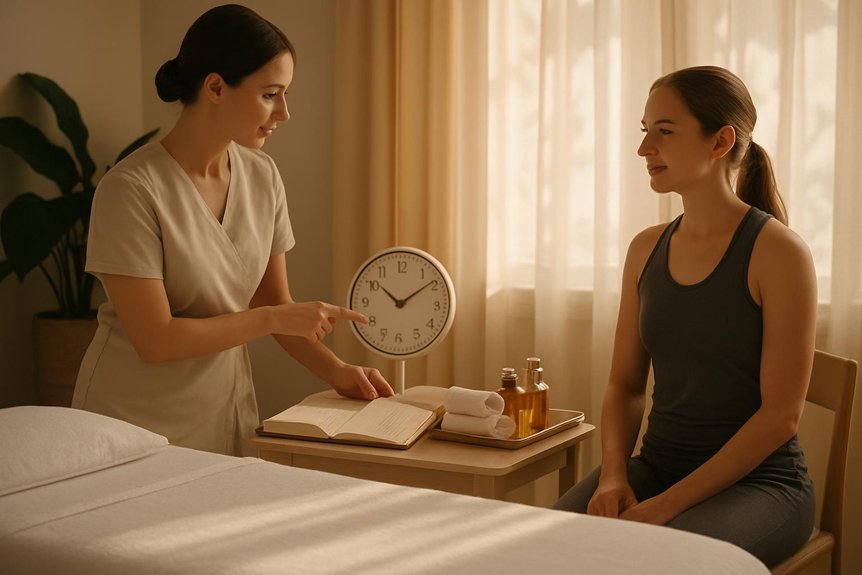
While individual goals vary, Spa & Massage structures athletic massage appointments to maximise clinical effectiveness and minimise downtime. Sessions are offered in focused 30-minute blocks, comprehensive 45–60 minutes, and extended 75–90 minutes for multi-region or complex presentations.
Intake includes a concise history, palpation, and range-of-motion testing to prioritise tissues—often the posterior chain, hip complex, scapulothoracic region, or plantar unit.
Treatment sequencing begins with targeted myofascial warm-up, followed by deep tissue and sports-specific techniques (trigger point, active release, pin-and-stretch), then joint mobilisation where indicated.
Therapists modulate pressure to the client’s comfort, using hypoallergenic oils common in clinic to preserve glide without masking texture changes.
Each session closes with re-testing, load-tolerance checks, and brief home guidance—breathwork, mobility drills, and gentle hydration cues.
When to Book a Series and How Often to Return
Curiously, the ideal cadence for athletic massage depends on tissue load, recovery windows, and the client’s clinical presentation.
At Spa & Massage, therapists propose series booking when pain is recurrent, training volume is rising, or a competition cycle demands predictable tissue quality.
Acute overuse (e.g., patellar tendinopathy, calf strain) benefits from 3–4 sessions over 2–3 weeks, prioritising myofascial release, graded pressure, and neuromuscular techniques.
Subacute patterns suit weekly sessions for 4–6 weeks, then taper.
For maintenance, most active clients return every 2–4 weeks; high-intensity athletes often book weekly during peak phases.
Book within 24–72 hours post-event for recovery, and 3–5 days pre-event for priming.
Our therapists reassess range of motion, tone, and pain provocation at each visit, refining dose to keep tissues supple, strong, and ready.
Conclusion
In the gym’s quiet forest, muscles are trees bending to seasonal winds. A 30-minute breeze prunes one branch; 45 to 60 minutes tend the canopy with precise myofascial strokes and graded pressure; 75 to 90 minutes restores the whole grove, integrating joint mobilisations and assisted stretching. Before competition, light trimming preserves elastic recoil; after, longer watering clears metabolites. Evidence guides the gardener’s hand: dosage, tissue tolerance, and load. At Spa & Massage, timing becomes terrain-aware stewardship.
